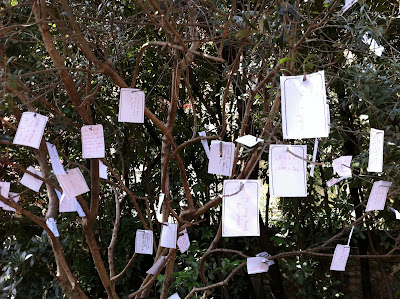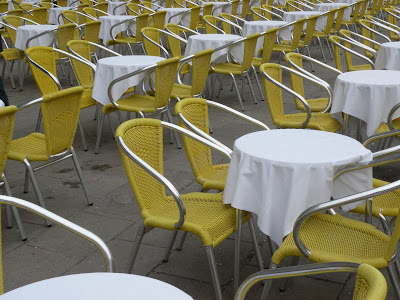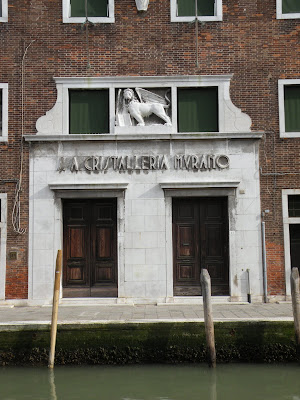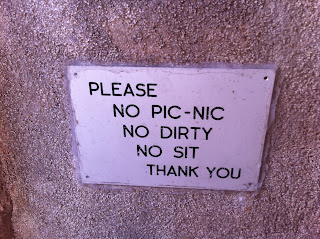To many friends' surprise, I had never been to Venice, Italy. I've been to so many other off-the-beaten-tourist-track destinations, that they automatically assumed I'd already covered Venice. It's up there with London & Paris, places I've enjoyed many times and can safely give tourists directions while in each city. So, as I found myself pondering which city I should explore on my next work trip to Europe, I started asking around...and Venice was on the top of list of my trusted traveller friends, who always followed it with "I can't believe you haven't been to Venice!"
With their recommendations came warnings... "It's really touristy", "It really stinks in the summer",
"It's so crowded" and one piece of advice: "Get lost". I was hoping the warnings were only applicable for the high season, and since I was going in March, I wasn't too worried. Getting lost? Although I do love to wander & explore, actually getting lost is something for novices. But I knew what they meant...
After a pleasant voyage across the Atlantic with a stop in Amsterdam, I landed in Venice in a misty rain. Well, since Venice is a lagoon island, you don't really land in Venice, you have to take an either really expensive (90euros) water taxi ride, or pile onto a Vaporetto, or water bus and take a 70 minute boat ride (seems a lot longer in the rain) to Piazza San Marco.
 |
| Benvenuti a Venezia...hmmm. |
This was not a time to get lost. There are no taxis in Venice, and by the time I unloaded my suitcase from the vaporetto, it was pouring rain. Fortunately, my hotel was only a few blocks away from the vaporetto stop. Another charming thing about Venice, in better weather conditions, are all of the little bridges over the canals. These are not suitcase friendly, so make sure you can carry what you pack.
Yeah, The rain made navigating the bridges extra special.
I soon arrived at my charming hotel, Hotel Flora, checked into my microscopic room that I was sharing with a friend in a day's time, and took a wee nap. I'll get lost later...
 |
| Alley way to Hotel Flora...on a sunny day. |
 |
| Terrace at Hotel Flora |
I woke up an hour later and ventured out with my map in hand, ready to get my bearings on this new city. I walked out of my hotel, took a left and ran into a lovely paper store called Il Prato. I'm sorry to say I didn't take any photos because I was so distracted by the beautiful paper products! The store's owner was very warm and welcoming while she stood behind the counter bookbinding a special product for a customer. Il Prato's products are handmade on site and original. They use vegetable dyes for their block printed papers and product line includes photo albums, desk top accessories, notebooks, and picture frames. Il Prato is not your typical paper store, which are scattered all over the city, and you pay a bit more for their handicrafts, but you won't be disappointed.
 |
| Photo album purchased at Il Prato, Venezia |
Purchase in hand, I took off to find the Rialto Bridge...I figured if I kept going in the general direction towards the canal and to the right every once in a while, I'd be sure to run across it...
I ended up in what looked more like Piazza San Marco...because it was. I had made a complete circle and ended up a few blocks away from my hotel...must have been the jet lag. ;)
The next day, I had the morning to myself again before my friend joined me so I wanted to go check out THE Museum of Venetian Art, the Accademia Galleries. The Accademia Galleries contain the most important Venetian paintings from the 14th-18th centuries. Read: More "Madonna col bambino"s that you could ever want to see. In my opinion, however, one artist stood out among the rest. His name was Giovanni Bellini, and he had a way of illustrating his characters with such real emotion, that I almost felt as if I was looking at photographs. Here are a few examples of what I thought were some of the best paintings in the Accademia...
 |
| Madonna and Child with Saint Sebastian |
 |
| Madonna and child with Saints Catherine and Magdalene |
 |
| Madonna of the trees |
It's no wonder he's said to have revolutionized Venetian painting and had a cocktail named after him.
After L'Accademia, I wandered down the canal to the Palazzo Venier dei Leoni, where Peggy Guggenheim's Art Collection is displayed in her former residence along the Grand Canal. I'm not a huge fan of modern art...so I wasn't quite sure how much I'd love her collection of surrealist and modern paintings and scupltures. But I was in Venice, and I actually really interested in seeing the palazzo itself. And besides, I'd heard there were a few pieces by Chagal and a Magritte painting in her collection, so those alone would satisfy my taste! There was also a lovely courtyard with a memorial to Peggy Guggenheim, and next to it grew the Wishing Tree, Yoko Ono's gift to Peggy's memory.
 |
| Yoko Ono's Wishing Tree |
However, my favorite discovery at the Peggy Guggenheim Museum was a small room in the back dedicated to Peggy's daughter, Pegeen's artwork. It was alive with color and while the colors were bright and happy, the paintings seemed to have a darker side to them. I'm going to write an entire blog entry about Pegeen, having read up on her life upon my return to the States, I'd love to share a bit about her most fascinating, yet short, life.
 |
Palazzo Venier - Grand Canal, Pegeen Vail Guggenheim
|
Once my friend, Sarah arrived in Venice, we'd set out to find all of the gems of Venice. We wandered along the canals, up and over innumerable bridges, while opting out of the gondola experience, thinking they were just as nice to look at from above.
 |
| Gondolas docked on the Grand Canal |
We made our way (with the help of our maps) to the Rialto Bridge and were rather disappointed. It's a beautiful structure, but is littered with graffiti and really bad tourist shops, and overflowing with people pushing their way across it. It is one of the few bridges that cross the Grand Canal, and definitely the most difficult and unpleasant to navigate...but you have to see it anyway, don't you?
 |
Rialto Bridge...best seen from afar.
|
After wandering over to the very first Jewish Ghetto (not the best claim to fame) in the Cannaregio district, we decided to try the whole "getting lost" thing... So we started walking back towards San Polo in hopes we'd find something to eat that wasn't necessarily kosher.
 |
| Campo Ghetto Nuovo |
And yes, everyone was right, it's when you wander that you see some of the most interesting sights in all of Venice, from beautiful monuments...to snapshots of everyday Venetian life...
 |
| Chiesa Degli Scalzi |
 |
| Scuola Grende di San Giovanni Evalgelista |
 |
Chisea di San Giacomo Dell' Orio
|
 |
| Woman walking with her market purchases |
 |
| Taxi! |
 |
| It's all about Mary |
 |
| Floating produce market |
Getting lost eventually makes one really thirsty...so we went to see what those famous Bellinis were all about down at a quiet little place near San Marco called Harry's Bar. (Don't know if you've heard of it) ;)
 |
| Salute! |
 |
| Home of the Bellini & former Hemingway haunt |
We pulled up a table next to another table full of Frommer's Guide to Venice readers and knew we must be in the right spot. Yes, home of the famous Bellini cocktail named after my new friend Giovanni at Harry's back in 1943. To hell with the fact that it cost 14 euros, it was one of those "must do" while in Venice that I really didn't mind admitting to doing.
Granted, on our last day, there were just a few more "must see" sights on our list... heard of Piazza San Marco or San Marco Square? Well, if the name doesn't ring a bell, maybe the pigeons will.
 |
| Piazza San Marco's famous pigeons |
The first thing I remarked at is that Piazza San Marco looks much larger and grander in photographs and painitings...and being the low season, there was a lot of scaffolding set up around construction sites, and I was a bit put off by the massive "Diesel" advertisement draped across an entire side of the Piazza...
But it was still Venice and it's when you're walking in the Piazza, strolling by Caffe Florian, that you're in the center of a city so unique in the world and it's no wonder it's captured the hearts of artists, writers, and visitors for centuries.
 |
| Misty morning in Piazza San Marco |
 |
| Another advantage to the off season...plenty of seating. |
 |
| Campinale |
Our first stop was the Byzantine style Basilica di San Marco, built in the 11th Century, which actually houses St. Mark's remains. One of the most amazing pieces within the basilica is the Pala d'Oro, a 14th century golden alterpiece inlaid with about a gazillion precious stones. Don't worry, the line outside moves fast, it's worth the wait, and it's free admission.
 |
| Basilica di San Marco |
 |
| Detail of Basilica di San Marco |
Next door is the Gothic style Palazzo Ducale or Doge's Palace. This was the political seat of Venice back in the day and contains stunning architecture, and great works of art portraying the history of Venice. My favorite room was the map room, which was covered in Old World Maps...it's fun to try and figure out what areas of the world some of them actually are dipicting and compare them to what we know today. I'd also not miss the "extended" prison cell tour, where you tour a few floors of the dark prison cells, before passing through the Ponte dei Sospiri, or Bridge of Sighs.
 |
| Outer wall design of Doge's Palace |
 |
| The Doge himself and the winged Lion of Venice |
 |
Inner courtyard of the Doge's Palace
|
The island of Murano was our next stop...not that either of us were into blown glass, but it seemed like a nice little place to spend the rest of the afternoon, strolling around. We were pleased to hear that our hotel had a "deal" with one of the Murano Glass factories that allowed us a complimentary water taxi ride to Murano that included a free tour of a factory, which sounded pretty sweet.
 |
| View from inside the water taxi...much faster and comfortable mode of transportation, we had to agree! |
Well, as long as you have some experience in either bargaining or being OK with walking away from a guilt purchase at the end of the tour, then you'll be just fine. If you're really interested in buying 12 pc sets of glass goblets or Murano chandeliers, then this is the place. I'd do some research before you go, however, to make sure what you're paying for is authentic. Murano is loaded with glass shops that sell either authentically made in Murano glass, or cheaper versions made in China. It's really what you want...
 |
One of many Murano Glass factories
|
Even if you don't love blown glass, it's a nice stroll around a smaller, quainter island...
 |
Canal in Murano
|
 |
| Steps down to the water...showing the changing tides |
 |
| I even found some Heather along the canals... |
Venice is definitely a must see on any traveller's list... Yes, it's crowded, and touristy, but there's definitely a reason that millions of people travel there every year. You don't have to even know too much Italian (although, it would be appreciated by the locals...I even got kissed simply because my friend spoke in Italian!) English seems to be the second (if not first) language in Venice...even if it sometimes gets lost in translation...
 |
| No dirty. Still a mystery. |
Ciao!

















































